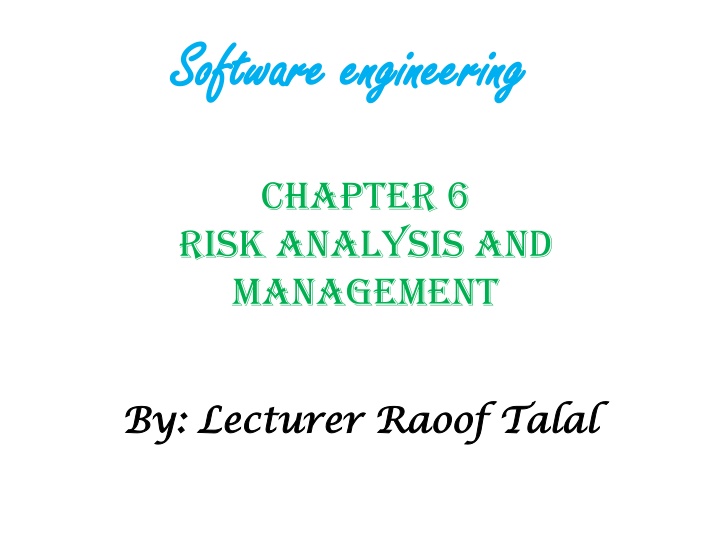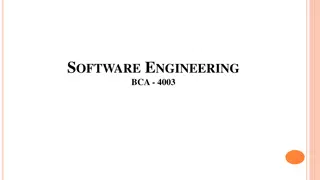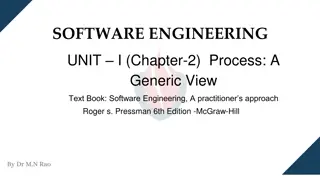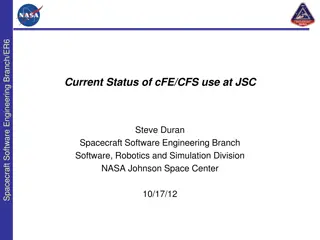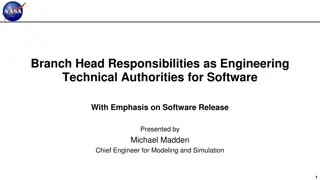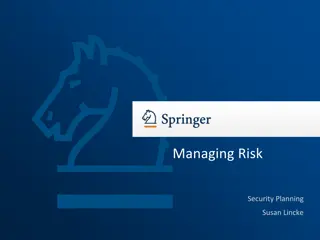Risk Analysis and Management in Software Engineering
Software risks, project risks, technical risks, and business risks all play a significant role in the success of software projects. Uncertainty and potential losses are key factors to consider when analyzing risks. Understanding the different categories of risks – such as project schedule delays, implementation challenges, and business viability threats – is crucial for effective risk management in software engineering.
Download Presentation

Please find below an Image/Link to download the presentation.
The content on the website is provided AS IS for your information and personal use only. It may not be sold, licensed, or shared on other websites without obtaining consent from the author.If you encounter any issues during the download, it is possible that the publisher has removed the file from their server.
You are allowed to download the files provided on this website for personal or commercial use, subject to the condition that they are used lawfully. All files are the property of their respective owners.
The content on the website is provided AS IS for your information and personal use only. It may not be sold, licensed, or shared on other websites without obtaining consent from the author.
E N D
Presentation Transcript
Software engineering Software engineering Chapter 6 Risk Analysis and Management By: Lecturer By: Lecturer Raoof Raoof Talal Talal
6-1 Software Risks Although there has been considerable debate about the proper definition for software risk, there is general agreement that risk always involves two characteristics: Uncertainty: the risk may or may not happen; that is, there are no 100% probable risks. Loss: if the risk becomes a reality, unwanted consequences or losses will occur. When risks are analyzed, it is important to quantify the level of uncertainty and the degree of loss associated with each risk. To accomplish this, different categories of risks are considered.
Project risks threaten the project plan. That is, if project risks become real, it is likely that project schedule will slip and that costs will increase. Project risks identify potential budgetary, schedule, personnel (staffing and organization), resource, customer, and requirements problems and their impact on a software project.
Technical risks threaten the quality and timeliness of the software to be produced. If a technical risk becomes a reality, implementation may become difficult or impossible. Technical risks identify potential design, implementation, interface, verification, and maintenance problems. In addition, specification ambiguity, technical uncertainty, technical obsolescence, and "leading-edge" technology are also risk factors. Technical risks occur because the problem is harder to solve than we thought it would be.
Business risks threaten the viability of the software to be built. Business risks often risk the project or the product. Candidates for the top five business risks are (1) building a excellent product or system that no one really wants (market risk), (2) building a product that no longer fits into the overall business strategy for the company (strategic risk),
(3) building a product that the sales force doesn't understand how to sell, (4) losing the support of senior management due to a change in focus or a change in people (management risk), (5) losing budgetary or personnel commitment (budget risks). It is extremely important to note that simple categorization won't always work. Some risks are simply unpredictable in advance.
Another general categorization of risks has been proposed: Known risks are those that can be uncovered after careful evaluation of the project plan, the business and technical environment in which the project is being developed, and other reliable information sources (e.g., unrealistic delivery date, lack of documented requirements or software scope, poor development environment).
Predictable risks are extrapolated from past project experience (e.g., staff turnover, poor communication with the customer, dilution of staff effort as ongoing maintenance requests are serviced). Unpredictable risks They can and do occur, but they are extremely difficult to identify in advance.
6-2 Risk Identification Risk identification is a systematic attempt to specify threats to the project plan (estimates, schedule, resource loading, etc.). By identifying known and predictable risks, the project manager takes a first step toward avoiding them when possible and controlling them when necessary.
There are two distinct types of risks for each of the categories that have been presented in Section 6.1: generic risks and product-specific risks. Generic risks are a potential threat to every software project. Product-specific risks can be identified only by those with a clear understanding of the technology, the people, and the environment that is specific to the project at hand. To identify product-specific risks, the project plan and the software statement of scope are examined and an answer to the following question is developed: "What special characteristics of this product may threaten our project plan?"
One method for identifying risks is to create a risk item checklist. The checklist can be used for risk identification and focuses on some subset of known and predictable risks in the following generic subcategories: Product size :risks associated with the overall size of the software to be built or modified. Business impact: risks associated with constraints imposed by management or the marketplace. Customer characteristics: risks associated with the sophistication of the customer and the developer's ability to communicate with the customer in a timely manner.
Process definition: risks associated with the degree to which the software process has been defined and is followed by the development organization. Development environment: risks associated with the availability and quality of the tools to be used to build the product. Technology to be built: risks associated with the complexity of the system to be built and the "newness" of the technology that is packaged by the system. Staff size and experience: risks associated with the overall technical and project experience of the software engineers who will do the work.
The risk item checklist can be organized in different ways. Questions relevant to each of the topics can be answered for each software project. The answers to these questions allow the planner to estimate the impact of risk. A different risk item checklist format simply lists characteristics that are relevant to each generic subcategory. Finally, a set of risk components and drivers" are listed along with their probability of occurrence. Drivers for performance, support, cost, and schedule are discussed in answer to later questions.
A number of comprehensive checklists for software project risk have been proposed. These provide useful insight into generic risks for software projects and should be used whenever risk analysis and management is instituted. However, a relatively short list of questions can be used to provide a preliminary indication of whether a project is at risk.
6-2-1 Assessing Overall Project Risk The following questions have derived from risk data obtained by surveying experienced software project managers in different part of the world. The questions are ordered by their relative importance to the success of a project. 1. Have top software and customer managers formally committed to support the project? 2. Are end-users enthusiastically committed to the project and the system/product to be built?
3. Are requirements fully understood by the software engineering team and their customers? 4. Have customers been involved fully in the definition of requirements? 5. Do end-users have realistic expectations? 6. Is project scope stable? 7. Does the software engineering team have the right mix of skills? 8. Are project requirements stable? 9. Does the project team have experience with the technology to be implemented?
10. Is the number of people on the project team adequate to do the job? 11. Do all customer/user constituencies agree on the importance of the project and on the requirements for the system/product to be built? If any one of these questions is answered negatively, mitigation, monitoring, and management steps should be instituted without fail. The degree to which the project is at risk is directly proportional to the number of negative responses to these questions.
6-2-2 Risk Components and Drivers The U.S. Air Force has written a handbook that contains excellent guidelines for software risk identification and cancellation. The Air Force approach requires that the project manager identify the risk drivers that affect software risk components performance, cost, support, and schedule. In the context of this discussion, the risk components are defined in the following manner:
Performance risk: the degree of uncertainty that the product will meet its requirements and be fit for its intended use. Cost risk: the degree of uncertainty that the project budget will be maintained. Support risk: the degree of uncertainty that the resultant software will be easy to correct, adapt, and enhance.
Schedule risk: the degree of uncertainty that the project schedule will be maintained and that the product will be delivered on time. The impact of each risk driver on the risk component is divided into one of four impact categories: negligible, marginal, critical, or catastrophic.
